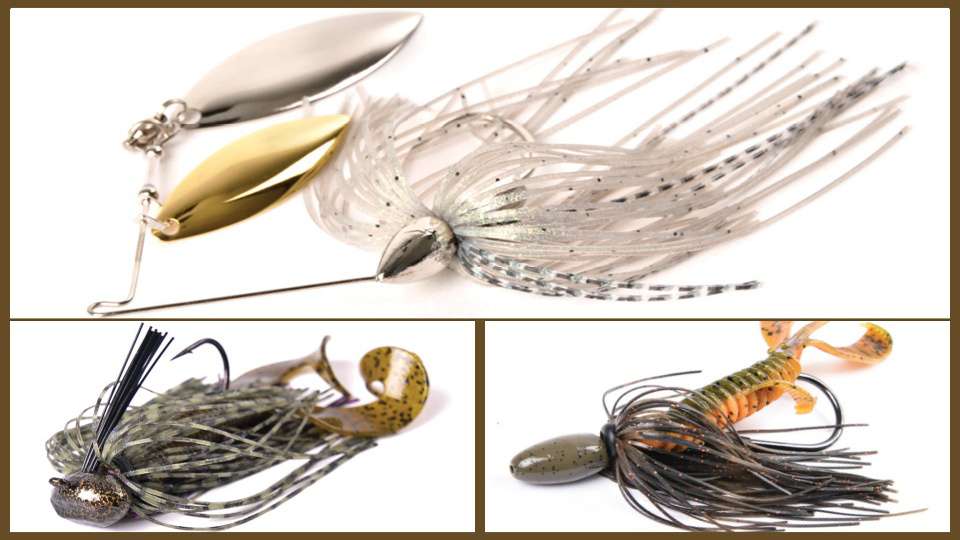
Days are growing shorter and temperatures are trending downward, so bass know it’s time to fill their bellies and pack on the weight that’ll get them through winter’s forthcoming lean period. Check out what these Bassmaster Elite Series anglers have to say about engaging fall whoppers.
As you will see, there’s more than one way to skin this cat. The pros choose a variety of lures and use them in myriad situations to target giant fish in autumn. These next couple months may offer you the best opportunity to catch a personal best, so take good notes before heading to the water’s edge. Remember, it’s pretty simple to catch a bunch of dinks, but who wants more little fish? If you are after a bass that will make your heart race, you need to be focused on the task.
Editor’s note: Land of Giants Fall | Winter | Summer
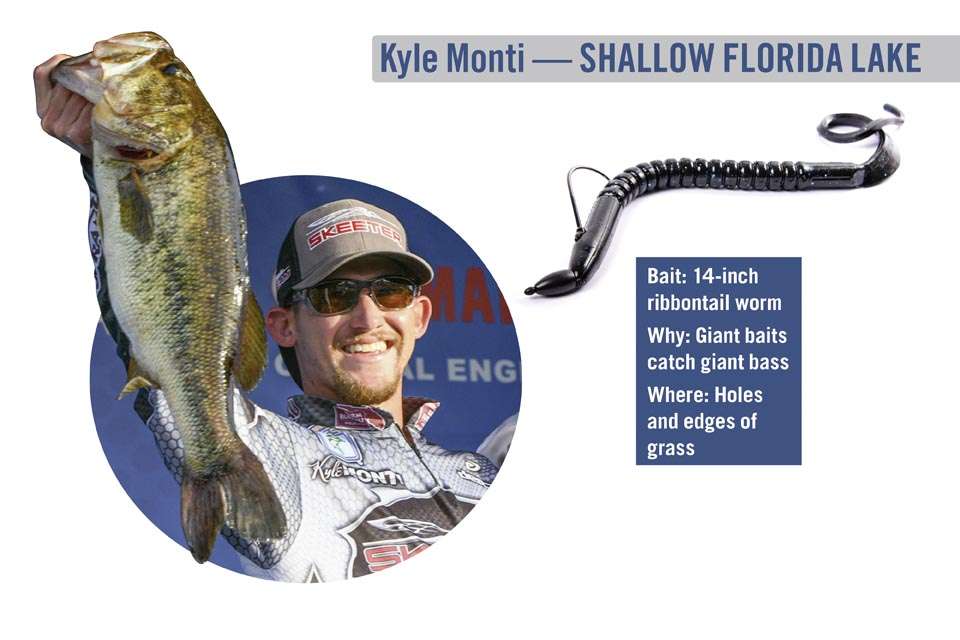
Kyle Monti
Hailing from Okeechobee, Fla., Kyle Monti clarifies that fall in Florida is very different from fall in the rest of the Southeast. First, air and water temperatures typically remain warm well into the fourth quarter; but from a topography standpoint, the lack of creek arms and pockets common to the man-made reservoirs dominating the bass scene means a less defined autumn migration.
“Most of our lakes don’t have contours, so you can’t even follow a creek channel,” Monti said. “Here, it’s more about area.”
That being said, Monti most often takes his fall giant hunt to offshore grass where bass enjoy the trifecta of shade, shelter and feeding. His bait of choice is a big worm — a seriously big worm. Specifically, he tempts those Florida-strain tanks with a 14-inch Bruiser Baits ribbontail beast called Da Big Nasty in black/blue or junebug for dark water and cloudy days or watermelon/red, watermelon candy or green pumpkin in clear conditions.
“I like this bait because it has a good length-girth ratio — it’s not so fat that it can’t get through the cover,” Monti said. “Also, because it’s a thinner worm, I don’t have to use a wide-gap hook.”
Monti Texas rigs his ribbon tail on a 7/0 long-shank worm hook with a pegged sinker. On the rare occasion that he fishes deeper than 10 feet (spring-fed lakes with brush and shell bottom), he uses a 1/2-ounce weight, but for his more common shallow-grass targets, he goes with a 3/8- or 1/4-ounce weight.
“I’m not punching this worm — I’m focused on holes and edges,” Monti said. “It’s a subtle presentation that slithers through the grass. I start with a 3/8, but if I can’t easily lift my rod from 9 to 11 o’clock, I go with the lighter weight.”
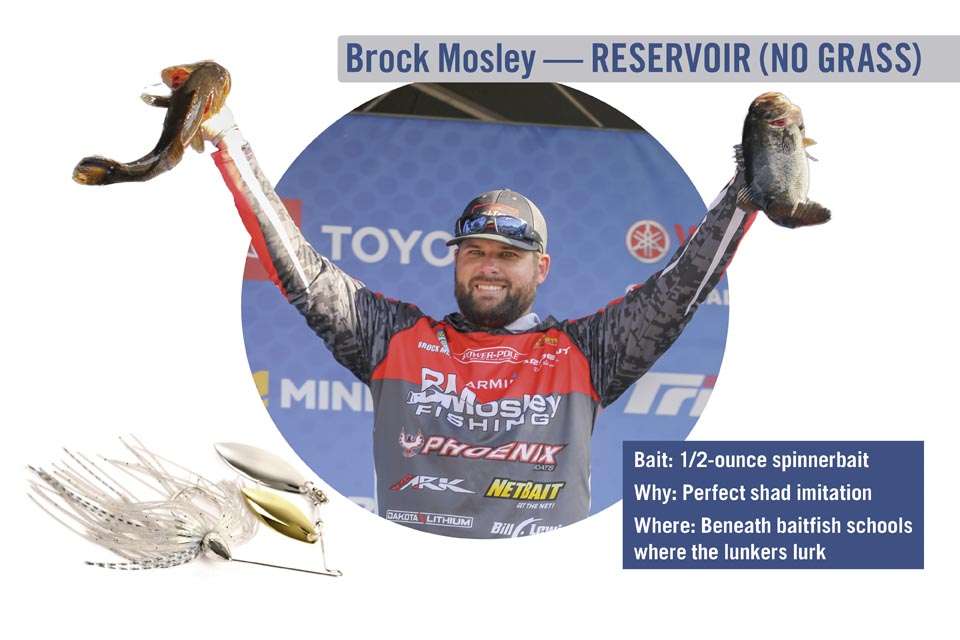
Brock Mosley
In lakes like Pickwick and Lewis Smith, where rock’s the dominant habitat feature, Brock Mosley knows that monitoring the movement of bait schools is the key to staying on top of the big bass. Timing, he said, is critical at fall’s onset, as it can take a week or so for the bass to catch up to bait schools moving into the backs of creeks.
“This time of year, the shad will be closer to the surface, where you can easily spot them on your sonar or visually see them on the surface,” Mosley said. “Schooling is the first and most obvious sign that the fish have caught up to the bait schools, but when you find the bait, you may have to fish around the school to see how the fish are reacting. The more aggressive they seem to bite, the more fish are probably in that little area.”
While a topwater will earn him plenty of bites, Mosley knows that the bigger fish typically suspend beneath bait schools. His favorite presentation: a 1/2-ounce spinnerbait in white or shad color and double nickel colored willowleaf blades.
“I like the willowleaf blades because there’s not as much resistance as you have with Colorado or Indiana blades, so I can burn the bait when I need to,” he said. “I keep it simple with no trailer, but I do like a 2/0 trailer hook. The fish are more competitive this time of year, so they’re usually more aggressive in their bites. A trailer hook ensures I catch whatever bites.”
Mosley finds that presentation preferences may vary from day to day, and even within a single day. That’s why he’ll keep showing the fish different spinnerbait looks, from slow rolling to burning, until he dials in a sweet spot that he can replicate.
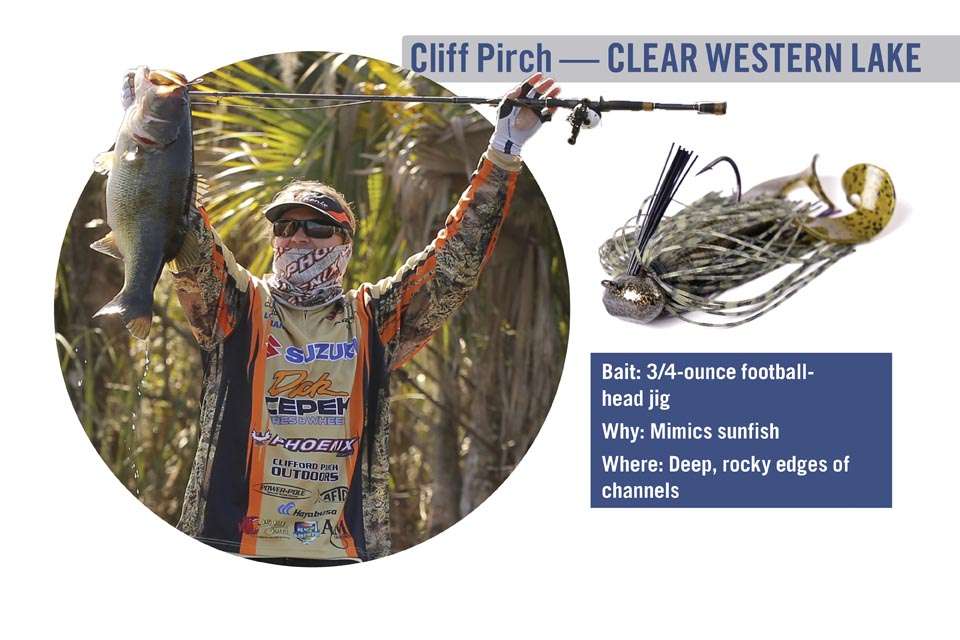
Cliff Pirch
Using northern California’s heralded Clear Lake as an example, Cliff Pirch describes a fall transition where bait schools departing the shallows will position along deeper rocky edges. Timing varies, but Pirch finds that years of meager shallow cover tend to hasten the movement, which produces some of his biggest fall fish.
With jumbo bass eating shad, as well as big sunfish along these drops, Pirch uses an alternating two-pronged attack, starting with a deep-diving crankbait that reaches 12 to 17 feet, possibly past 20 as the season progresses. Shad colors are always a good choice, but he’ll also use shades of green to match the sunfish.
Part two is a 3/4-ounce football-head jig with a Big Bite Baits Double Tail Grub trailer in bluegill colors or green pumpkin to mimic those sunfish. Pirch likes a moderate presentation speed that traces the bottom and often triggers monster bites when bumping across a high spot.
“Typically, they’re feeding when they’re in these areas, and when it’s right, there’s no question when you get a bite,” he said. “When those 6- to 12-pounders hit, they smoke it.
“Some days they want the crankbait, and other days they want the football jig. You may need to make a change to trigger a bite or if they’ve seen too much of one or the other. This is a great one-two punch for those big ones.”
Pirch said the bite could be near a lake’s river/creek arms or the main basin. The former’s typically off-colored water finds a shallower bite, while the latter’s deep, clear habitat finds him fishing deeper.
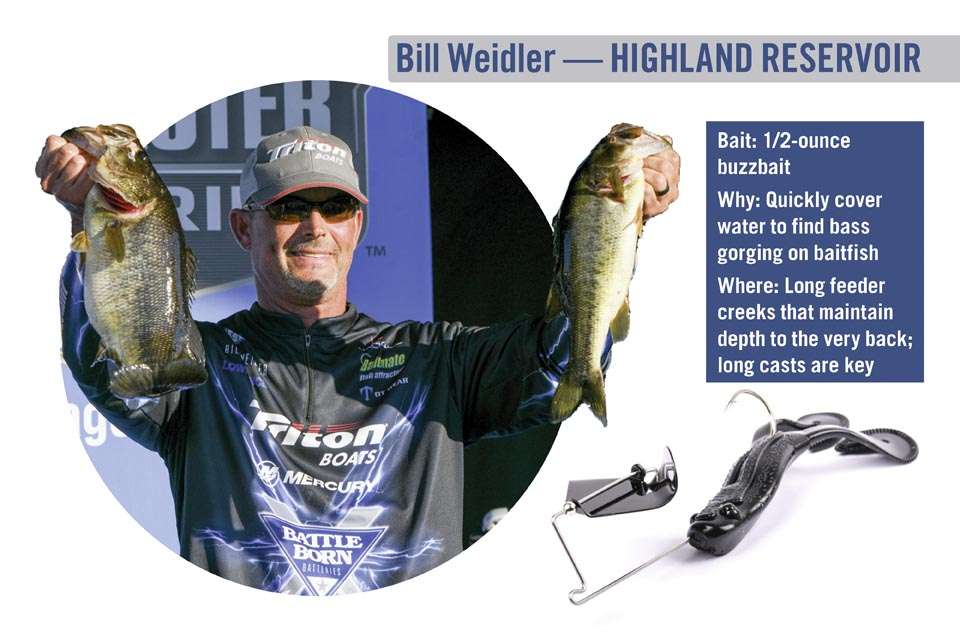
Bill Weidler
The key word for Bill Weidler’s fall strategy is “long.” Specifically, he wants long casts in long creek arms. Breaking that down, the Elite angler from Helena, Ala., said he won’t waste time in short pockets because they don’t offer the setup he believes favors big fish.
“I try to get on the creeks that have some depth to them,” Weidler said. “I don’t look for smaller pockets off the main river — it’s mostly longer creeks where you have a significant distance from the main channel to the back of the pocket. I’ll be targeting points, rock transitions and laydowns where baitfish push up into the backs of those pockets.”
Knowing that he might find his biggest fish up shallow, pushing shad onto the edges, Weidler’s bait of choice is a 1/2-ounce Dirty Jigs Scott Canterbury Buzzbait, which comes pre-rigged with a Bruiser Baits Thrasher for a big profile with lots of action. White is his primary color for matching baitfish, but he’ll go with black on overcast days.
“I rarely throw anything less than a 1/2-ounce [version], and the reason is I can get some good distance on it,” Weidler said. “The one thing I don’t want to do when I’m up fishing those schooling fish is have the boat get too close to where the baitfish are and spook them.”
Throwing his buzzbait on 50-pound Vicious braid helps maximize casting distance and ensure solid hook sets. Retrieve speed varies a bit, based on fish response, but Weidler definitely leans toward a peppier pace.
“When those fish are feeding on baitfish, they have so many options, the last thing I want to do is give them time to look at the bait,” he said. “Obviously, it’s going to look a little different than the baitfish coming through the water, but it’s creating that ripple on top of the water, similar to a baitfish. I like to move it pretty quick so they don’t have time to think — they just react to it coming over top of them.
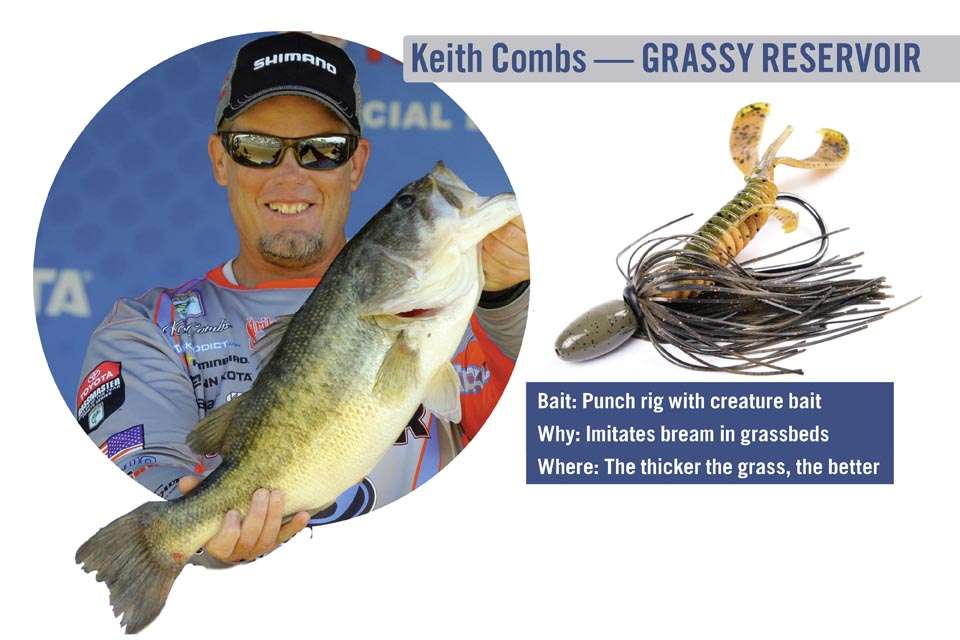
Keith Combs
Completely ignoring the more visible fall schooling activity, Elite veteran Keith Combs sets his sights on the unseen giants holding in thick, matted grassbeds inside major creek arms. His game plan may take time to develop and his numbers won’t be high, but the fish he yanks out of the salad are the ones he wants.
“I think a lot of the big ones that time of year are still around bream,” Combs said. “You’ll have big ones in open water, too, but that time of year, they get a lot tougher to catch because they’re very dialed in to the bait they’re feeding on. Those fish that are in the grass are easier to catch because they have cover around them and they can’t see you.
“Your average-size fish in the grass will be bigger because the forage I’m seeing that time of year is bluegill or big gizzard shad. So, the ones that are in there can eat big meals.”
Combs obliges these fall studs by offering a hefty punch rig comprising a 1- to 1 1/4-ounce Strike King Tour Grade Tungsten weight, a punch skirt and a Strike King Rage Bug with a 4/0 Strike King Hack Attack Heavy Cover Flipping hook on 65-pound Seaguar Smackdown braid. In the heaviest grass, he’ll switch to the slimmer Strike King Rage Craw, but with both, Combs employs a clever rigging tweak.
“I’ll peg my weight over the punch skirt, but I leave a very slight gap so the punch skirt can move up and down,” Combs said. “This allows it to rattle between the weight and the hook; it’s surprisingly loud. This creates a lot of noise when I’m yo-yoing the bait, and that often triggers bites.”
Noting this pattern’s requisite diligence, Combs adds, “You have to get in those areas and fish around. There may not be a rhyme or reason for where you get bites, but they tend to stay put, so there may be more than one in an area. You have to commit to this because you may not get bit for an hour, and then you might get three bites in one little area.”
Originally published in Bassmaster Magazine 2019.





